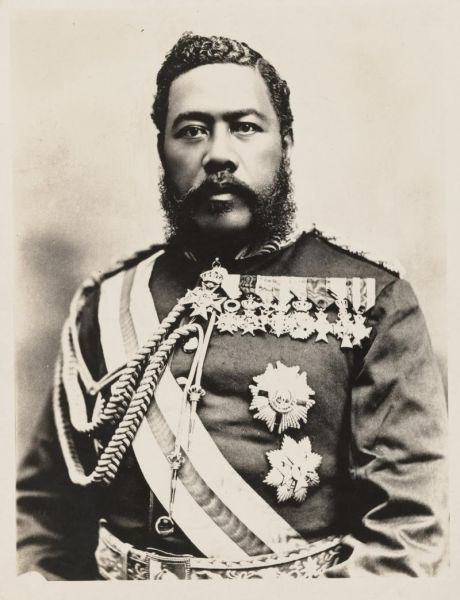Digital Collections
Celebrating the breadth and depth of Hawaiian knowledge. Amplifying Pacific voices of resiliency and hope. Recording the wisdom of past and present to help shape our future.
Kīhei de Silva
Haku mele: "Figgs" – Kalākaua’s pen name. Probably composed between 1860 and 1877, the years of Kīlauea’s service.
Sources: 1) HEN 3:871–872, Bishop Museum Archives. 2) Henriques-Peabody Collection, HI.M.77:54, Bishop Museum Archives. 3) Kaʻiulani Collection, HI.M.15:123, Bishop Museum Archives. 4) Kapiʻolani-Kalanianaʻole Collection, HI.M.30:427, Bishop Museum Archives. 5) Kapiʻolani-Kalanianaʻole Collection, HI.M.42(#3), Bishop Museum Archives. 6) Liliʻuokalani Collection, HI.M.7:133, Bishop Museum Archives. 7) Liliʻuokalani Collection, HI.M.28:32, Bishop Museum Archives. 8) Kimo Alama Keaulana Collection, MS Grp 329, 4.15.
Discography: 1) Sonny Chillingworth, Sonny Chillingworth, Mākaha MS 2014. 2) Eddie Spencer, Regal Refrains from Hawaiʻi’s Royal Era, Waikiki LP 338. 3) Eddie Spencer and various artists, Hawaiʻi’s Merrie Monarch, Kalākaua, Waikīkī LP 109.
Text below: Kapiʻolani-Kalanianaʻole Collection, HI.M.42(#3), BPBM Archives. Translation: Kīhei de Silva.
Nani ka huila o Kīlauea
I ka lawe mālie i ka laʻi
Koali lua a hoʻolaʻilaʻi
Kapalili i ka ʻili o ke kai.
HUI
Kaʻu wili pono ʻana ihola nō kā ia
E ka puʻuwai kapalili hoʻi
Kaʻu hana pono ʻana ihola nō kā ia
E ka puʻuwai kapalili hoʻi.
Nani wale hoʻi ka noho ʻana iho
E walea iki me Hanakahi
Pūʻiwa au lā hikilele i ka leo
Inā ua kali kāna hele.
Kīlauea’s propeller is wonderful
For gentle transportation in the calm.
It spins about and brings contentment
Thrumming on the surface of the sea.
CHORUS
And then I twist down carefully
O fluttering heart
And then I go at it completely
O fluttering heart.
Isn’t this the life
This relaxing for a while at Hanakahi.
But then I’m surprised, startled by the call:
"Let's go! Kīlauea has tarried long enough!"
The Kīlauea was a propeller-driven, sail-assisted, inter-island steamship that carried passengers, goods, and livestock during the reigns of Alexander Liholiho, Lot, Lunalilo, and Kalākaua. Although it is common practice in English to speak of all ships as "she," Hawaiians often assigned different genders to different vessels. The beautiful, clipper-style schooner Nettie Merril (called Neti in mele like "Waiho ʻAoʻao" and "Sugar Boiler"), for example, appears in several Kalākaua era compositions as a gorgeous woman of questionable character. On the other hand, the blocky appearance and unlady-like "equipment" of the Kīlauea (iron boiler, noisy machinery, single screw propeller) inspired haku mele to personify him in decidedly male terms.* He began his "checkered career" in 1860 and was finally retired in 1877 after having reputedly "scraped bottom on all the reefs of the [island] group" (Kuykendall, Hawaiian Kingdom, II:164). His propensity for accidents, however, did little to undermine the affectionate regard with which Hawaiians held him. Thus, he is celebrated in numerous mele for his persistence, endurance, and lack of caution. In "I Aloha ʻia ʻo Kīlauea," he is described as a heroic "horse of the sea" whose relentlessly spinning propeller drives him through wind and wave to deliver badly needed medical supplies to the people of Molokaʻi (Roberts, Ancient Hawaiian Music, 202; Pūkuʻi, Nā Mele Welo, 118–119). In "Maikaʻi Kaʻuiki," his "scooping propeller" is the last in a series of male images—eels, crowbars, bobbing duck necks, flowering bamboo stalks—meant to portray East Maui as fertile, ready, and much-desired (Nā Mele Welo, 164–169). And in "Māhukona,” he is an eager suitor who, in one interpretation at least, comes whirring over the surface of the ocean to discover that his sweetheart is already involved with another man.
Kalākaua’s "Nani ka Huila o Kīlauea" takes great delight in the double entendre of huila and wili, propeller and screw. The first verse can almost be taken as an innocent tribute to the work of the steamship: its splendid machinery allows for a smooth ride, satisfied passengers, and tireless delivery. The song’s chorus, however, is emphatically risqué and leaves little doubt that the Kīlauea is actually a male lover (in all likelihood, the author himself) whose skill at wili pono ʻana and hana pono ʻana is sure to bring the heart to full flutter. The song’s rarely heard second verse resumes the now transparent fiction of boat travel: the Kīlauea comes to port in Hilo and engages in a wonderful, absorbing, much-too-brief respite with Hanakahi (one task). The joy of this encounter is abbreviated by a call to depart. Boat leaves harbor, man leaves woman. Having delivered its cargo of contentment, the virile Kīlauea heads off to another port.
"Nani ka Huila o Kīlauea" has been recorded by Sonny Chillingworth and Eddie Spencer; neither version has liner notes, neither includes the final verse of "Nani ka Huila," and both have reorganized the single hui of the older manuscript texts into two separate choruses: "Kau hana na ka pono no ko ʻana na ka holo no ka ia [?] / I ka puʻuwai kapalili hoʻi" (used to open and close the song) and "Kau wili pono ʻana ihola no ka ia / I ka puʻuwai kapalili hoʻi" (used between the first and second singings of verse 1). I have big problems translating the first line of that first chorus, and I am more than a little uncomfortable with the second line switch from "E ka puʻuwai" to "I ka puʻuwai." Because of these uncertainties, I urge other "Nani ka Huila" enthusiasts to use my text, translation, and notes as a simple take-off point for additional study and comparison.
The essay above was written by Kīhei de Silva and published in his book He Aloha Moku o Keawe: A Collection of Songs for Hawaiʻi, Honolulu, 1997, pps. 13–14. It is offered here, in slightly revised and updated form, with his express consent. He retains all rights to this essay; no part of it may be used or reproduced without his written permission.
* Kimo Alama Keaulana has supplied the following description of the manner in which Hawaiians decided whether a ship was male or female: “My mother’s relative, whom we called ‘The Captain,’ was the captain of the ‘Humuʻula.’ How Hawaiians determined the gender of a ship depended upon the shape of the bow area of the ship. It is said that the forehead of certain kinds of fish told one what sex that fish was” (Personal communication, May 24, 1999).

photo courtesy of: Hawaiʻi State Archives

“Figgs” was a nom de plume that David Kalākaua seems to have favored when composing mele of a risqué nature. For example, both of his tongue-in-cheek boat songs, “Nani ka Huila o Kīlauea” and “Kāua i ka ‘Oni a ka Moku,” appear in the Kapiʻolani-Kalanianaʻole mele collection beneath the humorous, somewhat mock-heroic pseudonym. The text of the second mele is provided below.